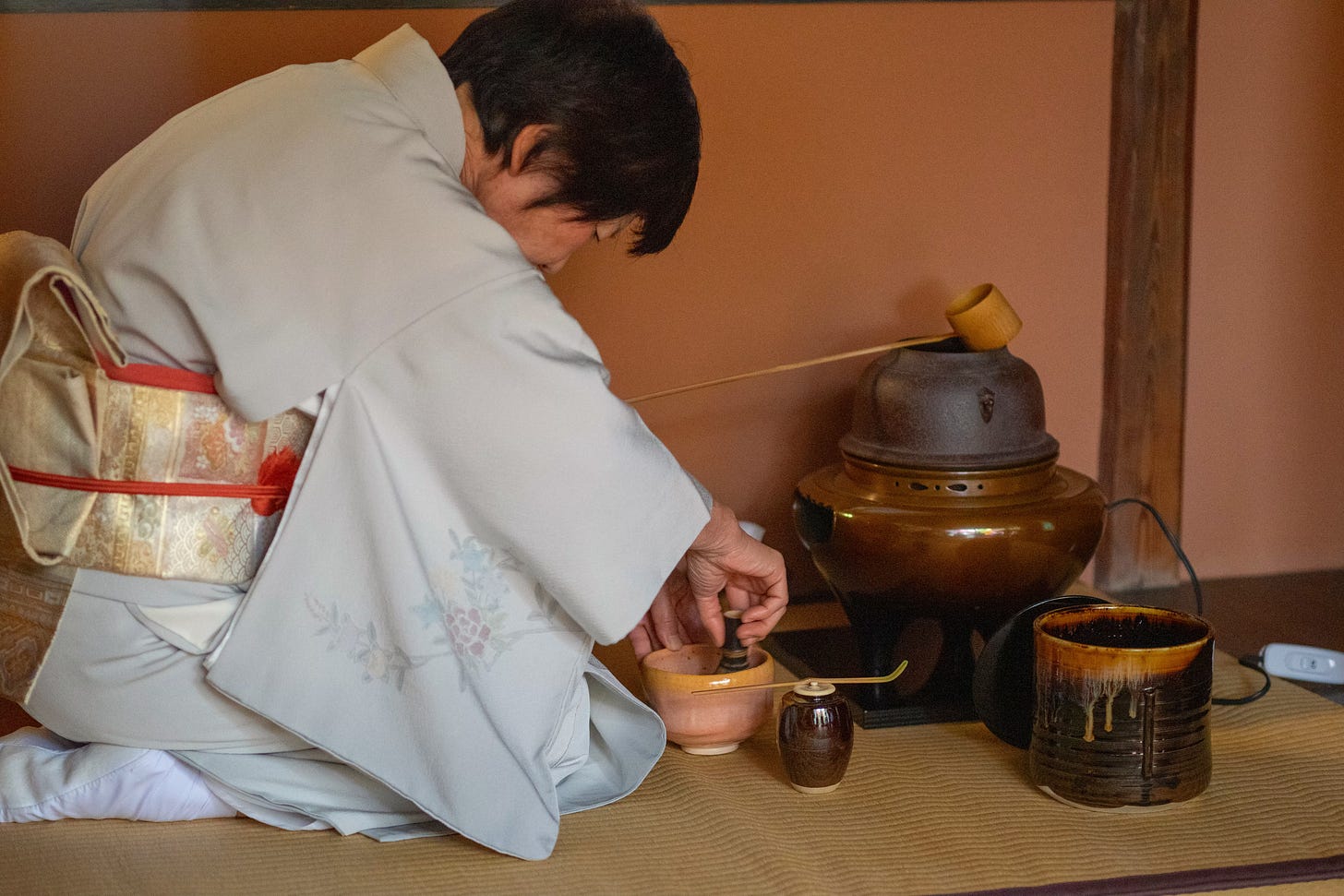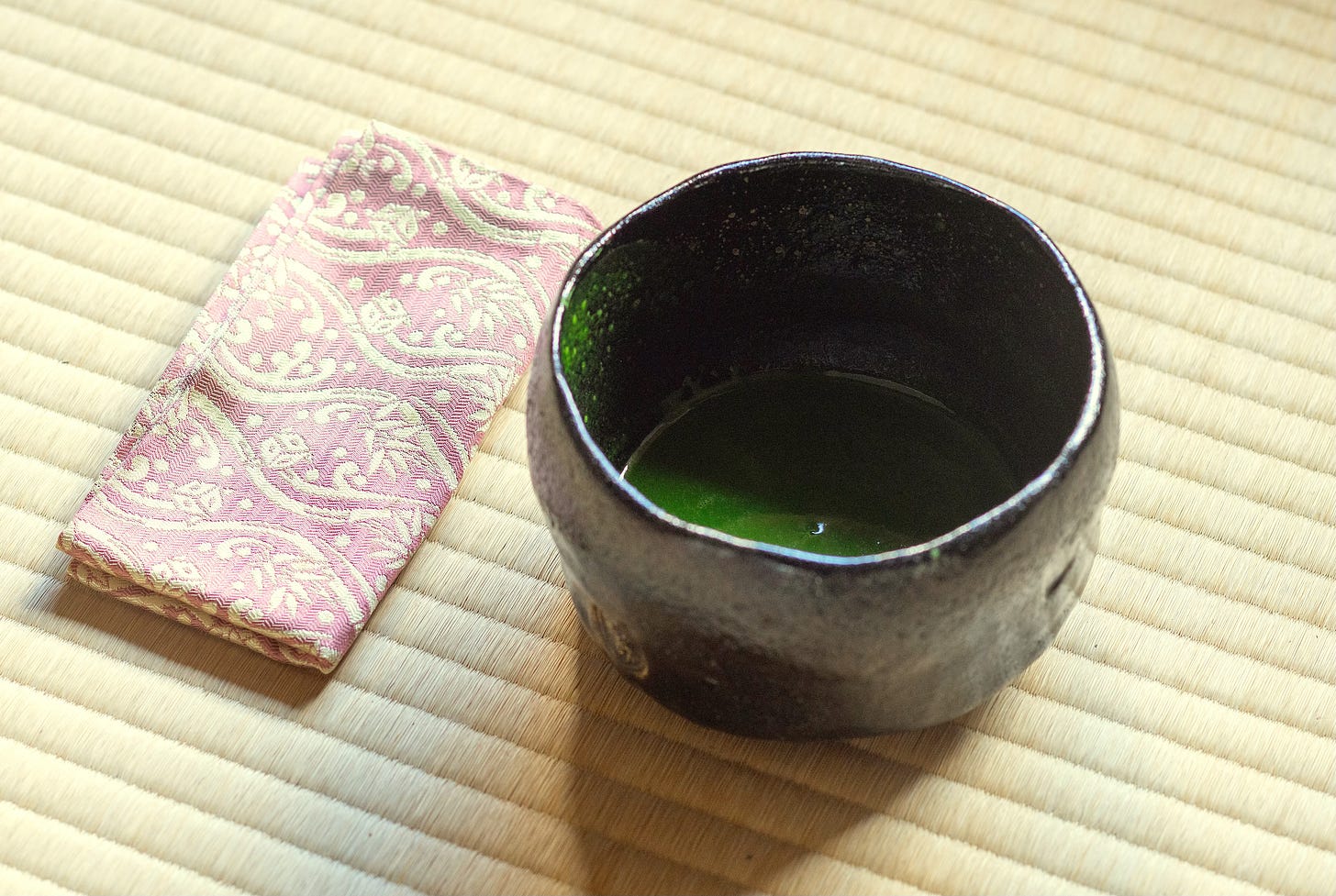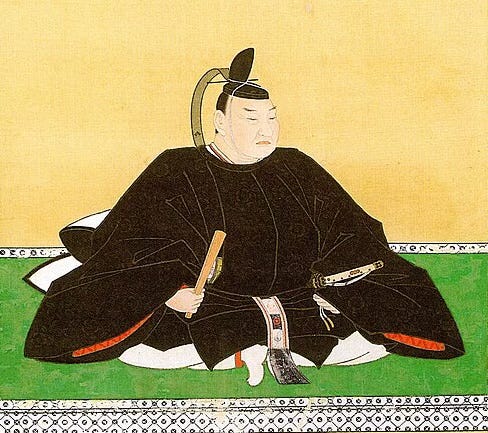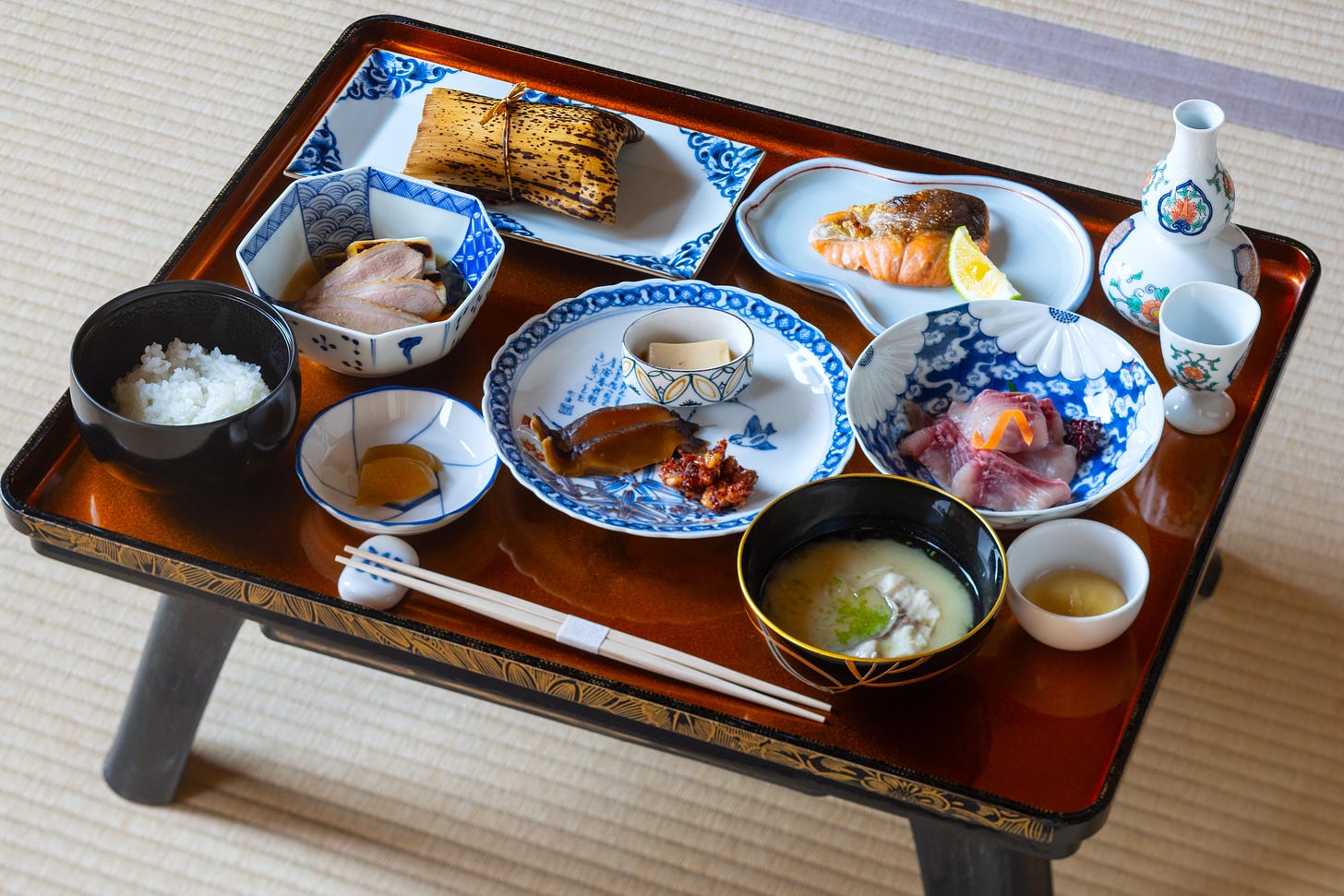The True Samurai Tea Ceremony and the Ichigo-Ichie Concept…
And Where You Can Experience it Exclusively in a Unique and Authentic Venue
Many people just visiting or even living in Japan are likely to experience partaking in a tea ceremony. Sitting in a traditional styled room or better still, in a true classical tearoom, with kimono clad assistants gracefully serving you small, colorful, seasonal wagashi sweets, while an honorable tea Sensei seated at the tiny hearth or chagama brazier, expertly whisks up frothy serves of thick green matcha tea in an elegant, timeless tea-bowl. Drink it down, box ticked and off you go.
And most people would be happy with that, thinking that they’ve experienced the true essence of Japanese culture. But a true, traditional Chaji Tea Ceremony was so more than just a cup of matcha tea with a sweet in a fine setting.
What is a Chaji Tea Ceremony?
Indeed, a true, conventional Chaji Tea Ceremony was more a gathering, featuring a full course meal consisting of traditional kaiseki cuisine, enjoyed slowly with conversation. The menu, the ingredients, even the cooking methods used, and the design of the Japanese sweets were all carefully selected by the host according to the time and season, and even the tastes of those invited. The host of these Chaji would consider how best to entertain his guests, and what would make them most relaxed and his respect for these guests were displayed in the skills and meticulous planning that would create the enjoyable few hours of the Chaji, which then led to the final cups of tea.
After enjoying the meal, guests would retire to another tearoom where a cup of thick matcha was elegantly served. The tea implements used in the preparation, the tea bowls to be used, the types of tea, the wagashi to be served, right down to the scroll hanging in the tokonoma alcove, the flowers displayed were all a follow on from the previous cuisine.
After this, a stroll through a garden enjoying the seasonal plants and views, or light chat in another section of the palace over items of mutual interest would be conducted, and the enjoyable gathering would be concluded with yet another lighter cup of green tea in a different setting yet again.
These Chaji Tea Gatherings led to the phrase Ichigo Ichie — a once-in-a-lifetime experience — being popularized by the Tea Master Sen no Rikyu in the Sengoku period and later refined by the Tairo, Lord Ii Naosuke of Hikone Castle. In true samurai sensibility, each tea ceremony, each situation was to be treated as a unique, and once in a lifetime moment shared by those in attendance. This situation was special, it would never be repeated again, and so the settings, the conversation, the atmosphere were all meant to be memorable.
Ichigo-Ichie…A Concept for Samurai to Live By
Ichigo-Ichie is a particularly Japanese cultural concept, a true samurai sensibility of treasuring a particular moment, and understanding that life can change at the drop of a hat. It reminds one that they should cherish every moment of any gathering, knowing that moment such as this will never be repeated; thus each moment is a once-in-a-lifetime experience.
In the chaos of the Sengoku, or Warring States period in which this was developed, and again in the late Edo period during Lord Ii Naosuke’s time, when chaos and uncertainty once again reigned, this was a concept to live by.
The Tea Ceremony - an Essential Skill of the Hikone Clan
For generations, the Ii clan, feudal lords of Hikone Castle, accumulated a deep knowledge of the tea ceremony. Due to their exalted position among the daimyo, the lords of Hikone were required to communicate with people from different positions and cultural backgrounds, from the Shogun himself and members of the Shogunate, to the various daimyo, and the Imperial Court. To prepare thoroughly with the other person in mind, to be sincerely attentive to the thoughts and needs of the guests, to realize that each meeting was a once-in-a-lifetime encounter, and to put these ideas into practice, they organized tea ceremonies at Hikone Castle and the Edo villas and invited guests of all ranks and position.
Lord Naosuke
Among the most accomplished was Lord Naosuke (1815–1860), exposed to the tea ceremony from an early age, he studied the Sekishu-ryu style of tea corresponding directly with the Sekishu-ryu tea master Katagiri Soen, which elevated his own understanding. He also explored the Zen spirit that underlies the tea ceremony, receiving a seal of approval from Zen Master Sen'ei, one of Japan’s most eminent monks.
Lord Naosuke mastered all the components of the tea ceremony. He wrote his own calligraphy for the hanging scrolls. He patronized Hikone’s pottery industry, making his own tea bowls, flower vases, serving plates and other tea ceremony utensils. He planned kaiseki cuisine menus and even made the wooden moulds required for producing rakugan dried confectionery.
Lord Naosuke became the lord of Hikone aged 36 in 1850, during the turbulent times of the late Edo period. It coincided with the arrival of Perry’s Black Ships in 1853, the multiple devastating earthquakes of the mid 1850’s and his becoming the Tairo, the Shogunate’s Chief Elder, akin to the Prime Minister in 1858, as the Edo Shogunate teetered on the brink of collapse. It was the time of the Ansei Political Purges, and the opening of Japan to foreign vessels, culminating in the Sakaradamon Incident in which Lord Naosuke was assassinated in Edo by anti-Shogunate rebels.
Some may consider it outrageous that Lord Naosuke held such cultural events during such chaotic times. However, the more one learns about the true meaning of the Tea Ceremony, the more one cannot help but think that in these troubled times, the tea ceremony was a necessity. It provided a respite, a time for communication, for listening to the diverse opinions of the shogunate, daimyo and Imperial Court, and quietly contemplating them afterwards. The tea ceremonies held at Hikone Castle and in Edo provided Lord Naosuke time to stop, think and consider.
This chance for communication — to listen and learn — is the significance of the tea ceremony at Hikone Castle, even for those of us in the 21st century.
Ii Naosuke is quoted as having said:
One’s full attention should be given to a Chaji tea gathering. Although the host and guests may meet often socially, each tea gathering is unique. As such, the gathering becomes a once-in-a-lifetime experience. The host, in true sincerity must take the utmost care in every aspect of preparation, leaving nothing to chance. The guests too — understanding that such a situation will never occur again — enjoy the setting created by the host.
True Experience
(#PR) Shiga Prefectures’ Omi Tourism Board and Hikone City have developed an exclusive unique experience based on the well documented Chaji tea ceremonies staged by Lord Ii Naosuke of Hikone Castle. Titled ‘The Lord's Tea Ceremony Experience’, it uses extant Edo period Hikone Castle facilities not open or available to the public, and traditional local chefs and craftsmen to reproduce a true Edo period Chaji Tea Ceremony.

Everything is authentic, and great pains have been taken to ensure that the experience is as historically accurate as possible allowing you to experience a true Chaji Tea Ceremony as would have been experienced by an important guest invited by the lord.
The historical venues include the extant Edo period Cultural Property listed Goshoin Palace, the retirement palace of Hikone Domain’s successive feudal lords and where Lord Naosuke was born, and the Jishin-no-ma tearoom (both off limits to the public) located in the famed Genkyu Rakurakuen Gardens, and the Houshoudai, a thatched roof tearoom providing a stunning view of the entire garden below.
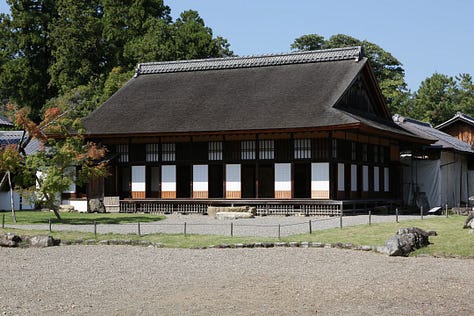
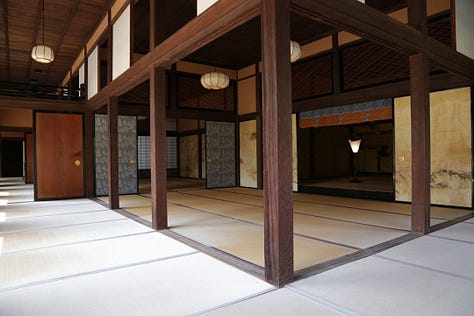
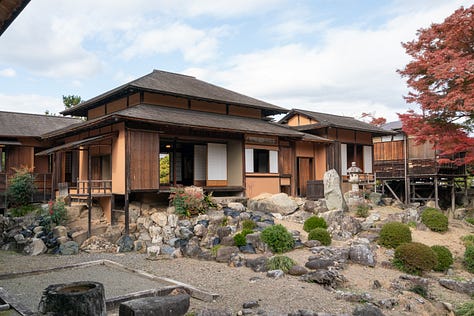
The Kaiseki cuisine is authentically recreated with locally sourced ingredients as per the well documented extant menus created by Lord Naosuke, with catering by the classically trained Goryori Iseiki restaurant chefs that once served the Ii clan. The sake served is the local Okamura Honke brand, established on the orders of Hikone’s Lord Ii Naosuke, and still popular to this day.
The actual Tea Ceremony is conducted by members of the official Hikone City Tea Ceremony Association, often using actual antique implements and bowls, while the Wagashi sweets have been created by chefs of the long-established Japanese confectionery shop, Itoju Kaho, purveyors to the Edo period Ii clan and a favorite of Lord Naosuke.

To ensure the Chaji goes well, and to add to the enjoyable atmosphere, an actor portraying Lord Naosuke solemnly entertains guests as the host. At the end, Lord Naosuke presents his guests with a special certificate in memory of their Ichigo-Ichie experience.

Experience Details & Dates
Restricted to just one group per date, a minimum of two, maximum of five people per group may participate.
The limited dates available, full details of the experience, application conditions, prices and booking forms can be found on the official website;
https://visit-omi.com/tea-ceremony
Part proceeds of these exclusive and private experiences are used for the maintenance and preservation of Hikone Castle’s extant structures to preserve these assets for future generations.
In the spirit of Ichigo-Ichie, this is a once in a lifetime — unique and exclusive — samurai history and cultural experience. Book your experience now, and Enjoy!




